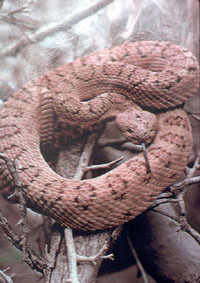ELDERBERRY …
A TINY BERRY THAT BRINGS THE GOOD THINGS IN LIFE
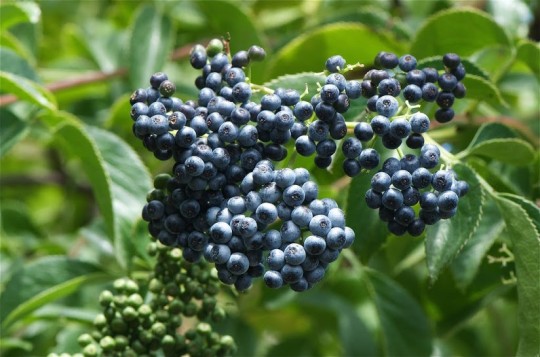 About Elderberry
About Elderberry
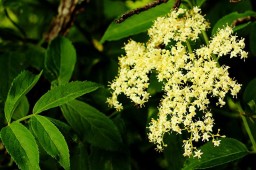 There are several species of Elderberry in the U.S., with the most common in the West being the Blue Elderberry; a deciduous shrub that can grow up to 30 feet high. Its leaves, 4 inches long and 2 inches wide, are arranged in opposite pairs with 5-9 serrated leaflets. In late spring and summer, the shrub bears tiny white elderflower clusters that can form into a group as large as 12 inches in diameter.
There are several species of Elderberry in the U.S., with the most common in the West being the Blue Elderberry; a deciduous shrub that can grow up to 30 feet high. Its leaves, 4 inches long and 2 inches wide, are arranged in opposite pairs with 5-9 serrated leaflets. In late spring and summer, the shrub bears tiny white elderflower clusters that can form into a group as large as 12 inches in diameter.
Flowers are pollinated by insects, and as the season progresses, the flowers fruit into drooping clusters of hundreds of dark purple to black berries.
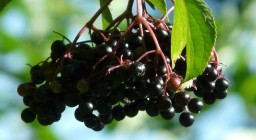
Then, in order to preserve moisture and nutrients, Elderberry will lose their leaves in late summer and turn green again with early winter rains.
Having said all of the above, I realized that the Elderberry I have been following the past three weeks is just now starting to flower … at a time when it is supposed to be bearing fruit! This realization caused me to have a genuine “crisis of confidence” and I began to think I was following another species and had definitely “blown it”. After several hours of scrutinizing pictures of the leaves on “my Elderberry,” I was positive that “my Elderberry” was indeed an Elderberry. That left another question, “What was going on with my Elderberry?” After consulting two experts on this issue, I learned that because of our variable and unpredictable California climate, Elderberries sometimes flower and fruit more than once a year. I guess this means that mine will be bearing fruit around Halloween!
Elderberry Provides Food
The berries of the Elderberry are edible, but only when cooked! Other parts of the plant, leaves, stems, roots, seeds and unripe fruits, are toxic … more on this later.
In the Past – The elderberry was extremely important to many native people for its numerous and varied uses, including food. Native inland groups harvested the berries in very large quantities throughout the summer and then carefully dried and preserved them for use in the winter. The berries were cooked into a rich sauce that needed no sweetening. Frequently, native families subsisted on Elderberry exclusively during long periods of the winter.
Although elderberry was not important as a food source for the Chumash, it was key to acquiring and preparing much of the protein in their diets. Why was that? Because elderberry wood is extremely hard, it is an excellent source of wood for tools. In particular, its branches were of prime importance in the making of bows and arrows for hunting. Chumash straight bows, called “self bows” were about 4 feet long and made of a single piece of elderberry wood. Unlike composite bows made of wood and sinew, these self bows could be taken on sea voyages, and did not become useless when they got wet. Because of this hunters could cross the Channel in their Tomols and were able to hunt on the Channel Islands, as well on the mainland.
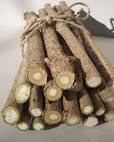
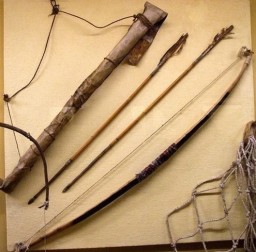
Shoots and branches of elderberries are filled with a soft tissue called pith, tissue that can be easily removed to leave a hollow tube. These tubes are well suited to serve as arrow shafts, that handily complete the bow/arrow pair for hunting. Other uses for the hard wood of Elderberry included squirt guns, blow guns, combs, spindles and pegs.*
What About Cooking? When it was time to cook, elderberry branches were made into “fire sticks”. Remember the old boy scout trick for starting fires … twirl a pointed hardwood stick until you get sparks and ignite some soft material (like dried pith)? Voila … fire! And yet another hollow stem could be used as bellows to blow air into the center of the fire.
After dinner … or any other time as well, might be time for a “smoke” … although much of the smoking was done before dinner. Hollow tubes made great pipes. And the tobacco? It was carried in those hollow tubes that had been converted into containers by plugging up one or two ends.
Today – Traditional methods of enjoying Elderberry include jams, jellies, syrups and pies, all of which are made by cooking down the fruit and straining out the seeds. (The elderberry jelly that I ordered from New Jersey just arrived and while its principal ingredient is sugar, it has a lovely, subtle flavor that I really liked.) And if you need a beverage for a really big celebration, you can serve elderberry wine or liqueur made from fermented berries.
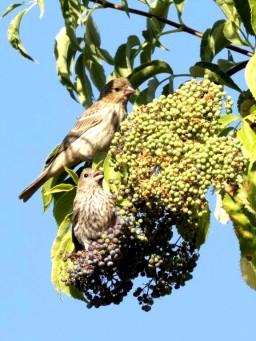 The importance of Elderberry for wildlife in various areas has been widely recognized. Numerous species of mammals and birds are known to consume its fruit or foliage, and apparently, they don’t have to cook the fruit first. For example, Elderberry is an important food source for native songbirds including western bluebird, ash-throated flycatcher, white-crowned sparrow and California thrasher.
The importance of Elderberry for wildlife in various areas has been widely recognized. Numerous species of mammals and birds are known to consume its fruit or foliage, and apparently, they don’t have to cook the fruit first. For example, Elderberry is an important food source for native songbirds including western bluebird, ash-throated flycatcher, white-crowned sparrow and California thrasher.
Birds also utilize larger elderberry shrubs for nesting sites. And happily, we have an example, right here on our very own More Mesa. Many of you know the significance of our signature bird, the White-tailed Kite because of its designation as a “California Bird of Special Concern”. In good rain years (lots of food) we have up to three nesting pairs on More Mesa. However, even in poor rain years we consistently have at least one nest at the most important, and historic, eastern nest site. Where is that nest … in a patch of Elderberries! Learn more about raising kite babies on the “Birds” section of our website.
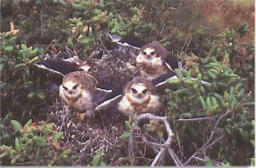
Elderberry Creates Music, Dancing and Ceremony
For the Chumash, musical instruments were also one of the major uses for elderberry wood. The hollow stems were fashioned into flutes and whistles. Holes to create the various notes were drilled with hot sticks. The elderberry flute, played for enjoyment and courtship, has 2 voices, and sounds different from each end. Unlike most flutes, which are played at the side of the mouth or straight down, this is played at a diagonal. And instead of a blow, it will just take the tiniest puffs, puffs that are very subtle.
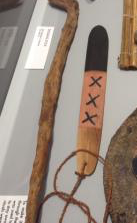
Ojai Museum
The Chumash also used Elderberry to make a split stick rattle that could be played by striking it on the hand or body, bringing it to a sudden stop or rapidly shaking it to produce clapping sounds. A third instrument, a bullroarer, was a piece of flat elderberry with a fiber string attached to one end … played by whirling it overhead to create a scary, whirring sound.*
The Elderberry is a Pharmacy
Berries of the Elderberry are one of the richest sources of vitamin C and also boast a high content of vitamin A, calcium, phosphorus and iron. Along with the flowers, they are packed with antioxidants and vitamins that may boost your immune system. Through the ages it has been extremely useful to people all over the world and to this day, is still widely considered one of the world’s most healing plants in alternative medicine.
In the Past: The written history of Elderberry dates as far back as 400 BC and Hippocrates, the “Father of Medicine”. He called the Elder Tree his
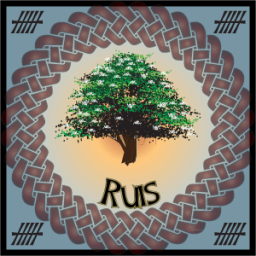
“medicine chest.” In the middle ages, Elderberry was considered a Holy Tree capable of restoring and maintaining good health, and as an aid to longevity. Native People in California used different preparations of flowers and leaves for various reasons; to treat colds, sore throats, fever, and also to induce sweating and relieve aches and inflammation. Poultices made from the flowers were used to treat wounds, improve the complexion, tone and soften the skin, and lighten freckles or spots.
It is well documented that the use of Elderberry as a pharmaceutical was as
important to the Chumash as its use for tools.*
Today: Today Elderberry continues to be lauded for its medicinal values. Modern compounds of Elderberry are used for many of the same reasons Elderberry was used by Native People and to aid in treating additional modern medical problems as well.
* To read more about Chumash tools, instruments and medicines, see pages 196-198 of “CHUMASH ETHNOBOTANY, PLANT KNOWLEDGE AMONG THE CHUMASH PEOPLE OF SOUTHERN CALIFORNIA” by Dr. Jan Timbrook.
Use With Care, There are Risks
The leaves, stems and roots of the Elderberry, as well as the seeds in the berries, have chemical compounds in them that metabolize into cyanide. Simply put, they are poisonous and can make you very ill! The only part of the plant that can be eaten is the fruit … but only after it is cooked.
Lots of Folklore and Magic Surround the Elderberry

It was believed in medieval times that the most likely time to encounter fairies was on Midsummer’s Eve, and under an Elder Tree. They also contended that chopping down an Elder Tree could release a spirit called the Elder Mother, who would take her revenge unless you had asked her permission first, and chanted her song. During various pagan festivals, people wore elderflowers to protect against witches and elderberry was planted to banish witches in various parts of the world. The wood of choice for making flutes used to summon spirits was, of course, Elderwood.
 And finally, we will end this Treasure Hunt with the “Elder Wand”, the most powerful wand in the wizarding world of Harry Potter … the one wand to rule them all. Wizards think Elderberry is pretty great too!
And finally, we will end this Treasure Hunt with the “Elder Wand”, the most powerful wand in the wizarding world of Harry Potter … the one wand to rule them all. Wizards think Elderberry is pretty great too!


 It All Starts with a Tiny Cactus
It All Starts with a Tiny Cactus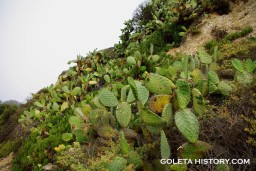 deeper and much closer to the cactus patch, they struck oil and struck it BIG! This one well alone yielded the richest oil yet found in California and ended up producing over a million barrels of high-quality crude. With two separate oil fields, one on land and one in the ocean, the coast at Ellwood quickly became a hot bed of oil activity; including extraction, refining, storage, and transportation. And because the area had so much going on, Kate Bell’s son-in-law feared that the revered cactus patch would be destroyed in the hustle and bustle of the oil field. So, he built an iron fence around the patch to protect it.
deeper and much closer to the cactus patch, they struck oil and struck it BIG! This one well alone yielded the richest oil yet found in California and ended up producing over a million barrels of high-quality crude. With two separate oil fields, one on land and one in the ocean, the coast at Ellwood quickly became a hot bed of oil activity; including extraction, refining, storage, and transportation. And because the area had so much going on, Kate Bell’s son-in-law feared that the revered cactus patch would be destroyed in the hustle and bustle of the oil field. So, he built an iron fence around the patch to protect it.

 built very quickly after Pearl Harbor. Our “line” of spotting stations stretched from Tecolote Canyon to east of Hope Ranch. Stations were staffed by both men and women, all civilian volunteers; among them some of Santa Barbara’s most prominent citizens. These folks worked around the clock in two-hour shifts. Using binoculars and checking against charts of various Japanese planes, spotters reported to “filter” stations using a buried phone line. The filter stations would then forward authenticated reports to an Aircraft Warning Service.
built very quickly after Pearl Harbor. Our “line” of spotting stations stretched from Tecolote Canyon to east of Hope Ranch. Stations were staffed by both men and women, all civilian volunteers; among them some of Santa Barbara’s most prominent citizens. These folks worked around the clock in two-hour shifts. Using binoculars and checking against charts of various Japanese planes, spotters reported to “filter” stations using a buried phone line. The filter stations would then forward authenticated reports to an Aircraft Warning Service. Our system was probably an early section of the Ground Observers Corps (GOC), a World War II Civil Defense program of the United States Army Air Forces to protect United States territory against air attack. By the beginning of November 1942, there were 1.5 million civilian observers in the GOC, who at 14,000 coastal observation posts performed naked eye and binocular searches to detect German or Japanese aircraft.
Our system was probably an early section of the Ground Observers Corps (GOC), a World War II Civil Defense program of the United States Army Air Forces to protect United States territory against air attack. By the beginning of November 1942, there were 1.5 million civilian observers in the GOC, who at 14,000 coastal observation posts performed naked eye and binocular searches to detect German or Japanese aircraft. Lizard … Bad Guy or Superhero?
Lizard … Bad Guy or Superhero? decided that the only reason I even thought about this issue was the expression “Lounge Lizard”; originally coined by the Flappers of the 1920s and used to describe men who hung around bars trying to pick up women … preferably rich ones. Apparently, the term has resurfaced every decade during the past 100 years and is still in use. With this flimsy negative evidence, and what follows, you decide whether the Western Fence Lizard may qualify as a Superhero.
decided that the only reason I even thought about this issue was the expression “Lounge Lizard”; originally coined by the Flappers of the 1920s and used to describe men who hung around bars trying to pick up women … preferably rich ones. Apparently, the term has resurfaced every decade during the past 100 years and is still in use. With this flimsy negative evidence, and what follows, you decide whether the Western Fence Lizard may qualify as a Superhero.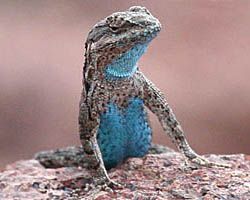 Of the three common lizards found on More Mesa, the Western Fence Lizard, also called Bluebelly, is a fairly well-known and recognized reptile. And it also seems to have captured the imagination of many northern California residents, as I found some of the most interesting information on this animal in Bay area publications.
Of the three common lizards found on More Mesa, the Western Fence Lizard, also called Bluebelly, is a fairly well-known and recognized reptile. And it also seems to have captured the imagination of many northern California residents, as I found some of the most interesting information on this animal in Bay area publications.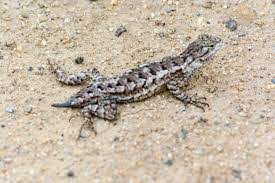
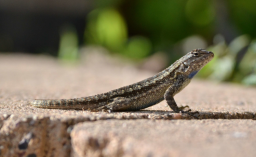 Stimulated by an increase in day length, Western Fence Lizards mate in the spring or early summer, and do not breed until the spring of their second
Stimulated by an increase in day length, Western Fence Lizards mate in the spring or early summer, and do not breed until the spring of their second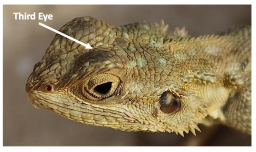
 pulled off Western Fence Lizards … and there are a lot of ticks on the lizards … never seemed to carry Lyme. His conclusion was that the lizard’s blood had unique proteins that killed off the bacterium. Since the incidence of Lyme in California was markedly lower that incidence in the Northeast, where there are no Fence Lizards, the difference was awarded to the tiny Fence Lizard and it became a Super Hero.
pulled off Western Fence Lizards … and there are a lot of ticks on the lizards … never seemed to carry Lyme. His conclusion was that the lizard’s blood had unique proteins that killed off the bacterium. Since the incidence of Lyme in California was markedly lower that incidence in the Northeast, where there are no Fence Lizards, the difference was awarded to the tiny Fence Lizard and it became a Super Hero. What really is happening, and why, exactly, does the Northeast have 226 times more Lyme cases than we do in California? According to a recent article in
What really is happening, and why, exactly, does the Northeast have 226 times more Lyme cases than we do in California? According to a recent article in 
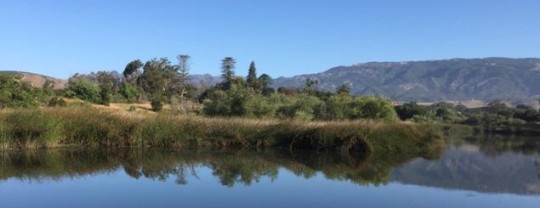 In the beginning there were reeds and sedges
In the beginning there were reeds and sedges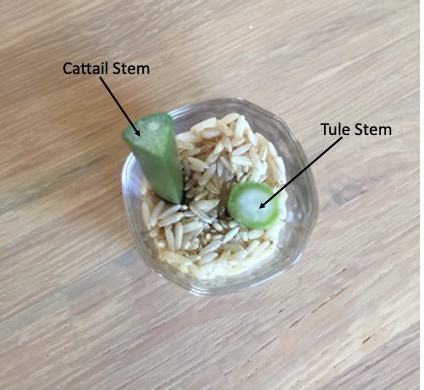 Bottom Line
Bottom Line
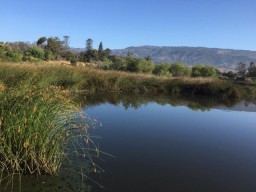
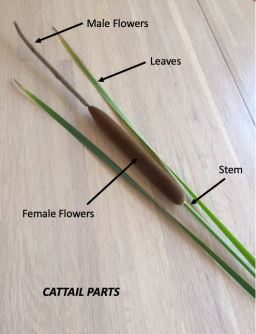 large diameter, brown, cylindrical female flower with a “fuzzy” appearance. This feature is responsible for the plant’s name and makes it easily identifiable as a “Cattail” … although it really looks more like a “corn dog!”
large diameter, brown, cylindrical female flower with a “fuzzy” appearance. This feature is responsible for the plant’s name and makes it easily identifiable as a “Cattail” … although it really looks more like a “corn dog!”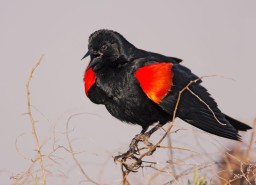 Cattails are important to tiny fish, waterfowl and animals alike. Birds make use of these marshy plants for food and shelter, as well as a source for nesting material. During nesting season, one of my favorite birds, the Redwing Blackbird often makes its home in thick Cattail patches.
Cattails are important to tiny fish, waterfowl and animals alike. Birds make use of these marshy plants for food and shelter, as well as a source for nesting material. During nesting season, one of my favorite birds, the Redwing Blackbird often makes its home in thick Cattail patches.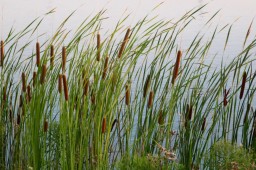
 Tules: I’m guessing the whole “Bulrush” thing started with the story of “Moses in the Bulrushes”. However, this “baby in the river” tale is not unique to Moses. It may have originated in the legend of Romulus and Remus who were left in the Tiber, or that of Sumerian King Sargon I, who was abandoned in a caulked basket in the Euphrates.
Tules: I’m guessing the whole “Bulrush” thing started with the story of “Moses in the Bulrushes”. However, this “baby in the river” tale is not unique to Moses. It may have originated in the legend of Romulus and Remus who were left in the Tiber, or that of Sumerian King Sargon I, who was abandoned in a caulked basket in the Euphrates.
 Prologue
Prologue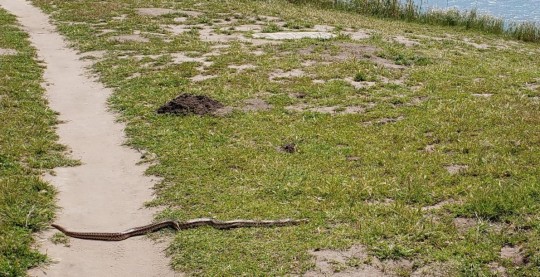
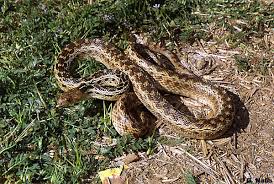 hikers deliberately kill Gopher Snakes because they are mistaken for Rattlesnakes. (As far as I know there has never been a report of a Rattlesnake on More Mesa.) Both species have similar coloration, markings and large heads. In addition, they are both known to hiss loudly, vibrate their tails and flatten their heads when threatened … a set of defense mechanisms designed to ward off potential predators. In the case of the Gopher Snake, this display is a type of mimicry, where they, a harmless species, mimic a harmful species … a Rattlesnake. However, while mimicry may be helpful in keeping predators away, it can cause problems for Gopher Snakes. Humans decide to kill them thinking they are venomous Rattlers. Instead, those who come upon a snake should take a quick look. A few ways to tell the two species apart is that Gopher Snakes are much longer and slimmer. Further, even though they can make a repetitive sound with their tails, they don’t have rattles. If it is obvious that the snake, whether it is a Rattler or a Gopher Snake, feels threatened, the wisest and most humane course of action is to simply go away. Once it figures out that it is not being threatened, the snake will also just go away.
hikers deliberately kill Gopher Snakes because they are mistaken for Rattlesnakes. (As far as I know there has never been a report of a Rattlesnake on More Mesa.) Both species have similar coloration, markings and large heads. In addition, they are both known to hiss loudly, vibrate their tails and flatten their heads when threatened … a set of defense mechanisms designed to ward off potential predators. In the case of the Gopher Snake, this display is a type of mimicry, where they, a harmless species, mimic a harmful species … a Rattlesnake. However, while mimicry may be helpful in keeping predators away, it can cause problems for Gopher Snakes. Humans decide to kill them thinking they are venomous Rattlers. Instead, those who come upon a snake should take a quick look. A few ways to tell the two species apart is that Gopher Snakes are much longer and slimmer. Further, even though they can make a repetitive sound with their tails, they don’t have rattles. If it is obvious that the snake, whether it is a Rattler or a Gopher Snake, feels threatened, the wisest and most humane course of action is to simply go away. Once it figures out that it is not being threatened, the snake will also just go away.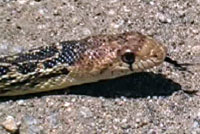 There is no need to exterminate Gopher Snakes. These animals, while they can be intimidating because of their size and may look a bit like Rattlesnakes, represent no threat. Gopher Snakes are nonvenomous. However, if you provoke it, a Gopher Snake may bite and the bite may hurt. As for the big picture regarding venomous snakes in the United States, recent statistics show that five to six thousand people a year are bitten by them. Five of those people die because they did not seek medical care.
There is no need to exterminate Gopher Snakes. These animals, while they can be intimidating because of their size and may look a bit like Rattlesnakes, represent no threat. Gopher Snakes are nonvenomous. However, if you provoke it, a Gopher Snake may bite and the bite may hurt. As for the big picture regarding venomous snakes in the United States, recent statistics show that five to six thousand people a year are bitten by them. Five of those people die because they did not seek medical care.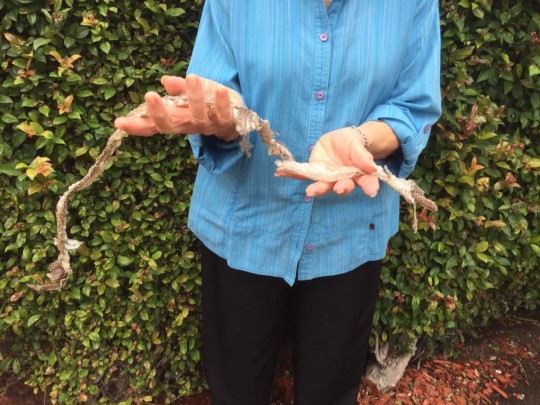 (This skin is in 2 pieces because I carried it in my jacket pocket to show More Mesa visitors and it received some rough treatment.) The shedding process is necessary to accommodate growth and to remove parasites on the old skin. Since the skin does not grow with the individual, as ours does, the snake has to do something entirely different. It starts by growing a new layer of skin under the old one. When the new layer is complete, the snake removes the old one. It’s just like taking off a sock. First it makes a small tear in the old skin, somewhere on the head area, by rubbing against something rough. Then it slithers out of the old skin and leaves it behind and it is usually inside out. Snakes shed their skin, on average, two to four times a year, varying with age and species. However, young snakes that are actively growing may shed every two weeks … compared to older snakes who may only shed twice a year.
(This skin is in 2 pieces because I carried it in my jacket pocket to show More Mesa visitors and it received some rough treatment.) The shedding process is necessary to accommodate growth and to remove parasites on the old skin. Since the skin does not grow with the individual, as ours does, the snake has to do something entirely different. It starts by growing a new layer of skin under the old one. When the new layer is complete, the snake removes the old one. It’s just like taking off a sock. First it makes a small tear in the old skin, somewhere on the head area, by rubbing against something rough. Then it slithers out of the old skin and leaves it behind and it is usually inside out. Snakes shed their skin, on average, two to four times a year, varying with age and species. However, young snakes that are actively growing may shed every two weeks … compared to older snakes who may only shed twice a year. When I started researching this Treasure Hunt, I was intrigued by why it is that humans are afraid of snakes. My first thought was to blame it on Adam and Eve. But it turns out, that it is in our nature to be afraid of snakes; that is, it is embedded in our DNA. Research over the past 10 years has given us some clues to the answer. In the beginning, early primates, and then humans, developed pattern recognition schemes for predators like lions, bears etc. But snakes don’t look like these kinds of predators … they look like sticks. Furthermore, they do not move like other predators … they slither. This would imply that the existing pattern recognition algorithms didn’t work. Then evolution took over, and humans who figured out they should fear snakes would have been at an advantage for both survival and reproduction. One clear indicator of this advantage was highlighted in a recent study. In that work, researchers found that both adults and children could detect images of snakes among a variety of non-threatening objects more quickly than they could pinpoint frogs, flowers or caterpillars. The implication is that we humans can identify snakes much more quickly than other things. This piece of our DNA is the reason that people who live in industrialized countries fear snakes … even when they have never ever seen one!
When I started researching this Treasure Hunt, I was intrigued by why it is that humans are afraid of snakes. My first thought was to blame it on Adam and Eve. But it turns out, that it is in our nature to be afraid of snakes; that is, it is embedded in our DNA. Research over the past 10 years has given us some clues to the answer. In the beginning, early primates, and then humans, developed pattern recognition schemes for predators like lions, bears etc. But snakes don’t look like these kinds of predators … they look like sticks. Furthermore, they do not move like other predators … they slither. This would imply that the existing pattern recognition algorithms didn’t work. Then evolution took over, and humans who figured out they should fear snakes would have been at an advantage for both survival and reproduction. One clear indicator of this advantage was highlighted in a recent study. In that work, researchers found that both adults and children could detect images of snakes among a variety of non-threatening objects more quickly than they could pinpoint frogs, flowers or caterpillars. The implication is that we humans can identify snakes much more quickly than other things. This piece of our DNA is the reason that people who live in industrialized countries fear snakes … even when they have never ever seen one!